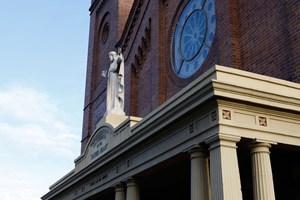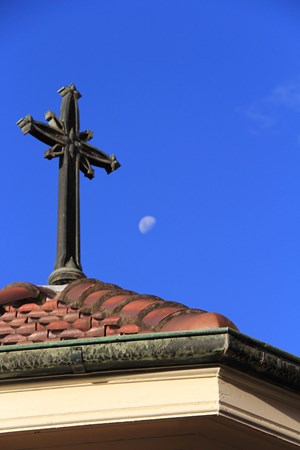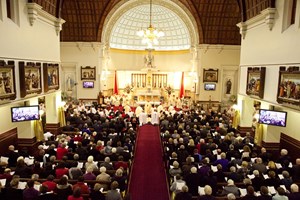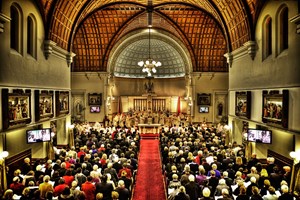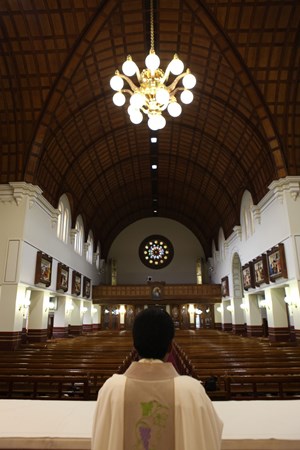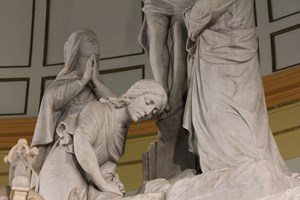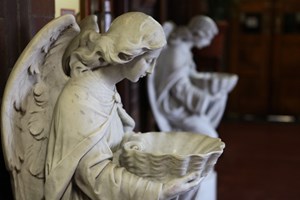Parish List
- Home
- About
- Church & Mission
- Support Us
- Catholic Life
- National Plenary Council & Diocesan Synod
- Children's Ministries
- Mission and Outreach
- Diocesan Protection and Safety Council
- Change Loss and Grief
- Ecumenism
- Perpetual Day of Remembrance
- LGBTIQ Forum
- Visiting Clergy - Citizens/Residents of Australia
- Visiting Clergy - International Visiting Australia
- Agencies
- News & Events
- People
- Places
- Mass Times App
Sacred Heart Cathedral
 Sacred Heart Cathedral, Hamilton is a beautiful and welcoming place of worship which acts as both the Hamilton Parish church and the Cathedral for the Catholic Diocese of Maitland-Newcastle.
Sacred Heart Cathedral, Hamilton is a beautiful and welcoming place of worship which acts as both the Hamilton Parish church and the Cathedral for the Catholic Diocese of Maitland-Newcastle.
The Sacred Heart Cathedral building was opened in 1930 as the parish church of Hamilton and was consecrated by Bishop Edmund Gleeson in 1941, before becoming Sacred Heart Cathedral on July 16, 1995.
Very much a church of the people, the Sacred Heart Church's foundations were dug with the physical aid of parishioners. The church was built virtually, brick by brick, on the dream of Monsignor Victor Francis Peters and through the generosity of parishioners who, in the midst of the Great Depression, bought bricks for an average of twopence each. A donation of ten pounds was the norm and in total, 700,000 bricks were used.
Monsignor Peters was influenced by the architecture of the Cathedral in Thurles in Ireland; the Cathedral Church of Philadelphia in USA and the brick work in front of the Pisa church in Italy. The foundation stone was laid on September 23, 1928. The first brick was laid on February 1, 1929 and the last brick just ten months later on December 1, 1929.
Sixty years later, the earthquake of 1989 caused considerable damage particularly to the belltower. The original concrete dome was replaced by one of copper and the original dome now stands as a memorial to those who lost their lives in the earthquake.
The earthquake also caused significant damage to St John's Pro-Cathedral in Maitland. Because of the change in direction of population movement, Bishop Leo Clarke took the opportunity to petition Rome for a change in name, and the "Diocese of Maitland" became the "Catholic Diocese of Maitland-Newcastle" and the Church of the Sacred Heart became the Cathedral.
By Papal Brief dated June 14 1995, the Diocese of Maitland-Newcastle was created and on July 16 1995, the Sacred Heart Church in Hamilton became the Sacred Heart Cathedral for the Catholic Diocese of Maitland-Newcastle.
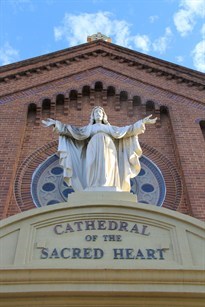 Passers-by will notice the outstretched, enfolding arms of the marble statue of the Saviour outside, welcoming all to the Sacred Heart Cathedral. The invitation "Venite Ad Me Omnes" (All come to me) is often taken up by passers-by.
Passers-by will notice the outstretched, enfolding arms of the marble statue of the Saviour outside, welcoming all to the Sacred Heart Cathedral. The invitation "Venite Ad Me Omnes" (All come to me) is often taken up by passers-by.
The beautiful architecture and stunning, colourful grounds make Sacred Heart Cathedral a perfect choice for weddings and baptisms, and often holds large funeral services for members of the diocese who have passed away.
The Cathedral also plays a pivotal role in important diocesan events, hosting the annual Chrism Mass in Holy Week and the annual Called To Serve Mass for Catholic school teachers.
Architecture
Built in Romanesque style, the Cathedral achieves a pleasing sense of harmony in its cruciform shape. As one approaches the entrance one's eyes are lifted to the lovely Carara white marble life-sized statue of the Saviour; originally standing on a terra cotta base, harmonious with the design of the terra cotta portico. This base was later painted cream as were the doric columns of the portico.
Around the entire body of the Cathedral, a decorative border of bricks, comprising one stretcher above three soldiers then reversed, is displayed under corbelled bricks. The border is featured encircling the tower and also above the splayed bricks which form the plinth around the external walls. Further, the Greek Key design (Maiandros) is prominent on the exterior and in the interior of the cathedral.
Of great anecdotal interest is the story of the two bronze crosses which crown the roofs of the tower and the baptistry.* These crosses were made by a prominent Newcastle Communist known as "Red Arthur". A coppersmith by trade, Arthur was highly thought of for his expertise. His family background was Catholic and his mother was fervent in her faith. A firm friendship existed between two men diametrically opposed in their concept of religion, yet sharing a common ground in their love of others. The men were Arthur and the then Fr Victor Peters.
A bargain was struck between them. Arthur proposed that he would charge for the cross on the belltower but would donate the baptistry cross which would stand as a remembrance of his mother but the coppersmith must have a free hand in the design. Fr Peters agreed to this request. The crosses were originally meant to be identical. Observation reveals that the baptistry is crowned by an ornate cross which stands as a tribute to a son's love and a priest's compassion.
In his description of Sacred Heart Cathedral, the architect Peter Gannon observed "the design of the interior of the cathedral is pleasing, and the composition happy. There is sufficient detail, yet this is not overdone, and worshippers entering the cathedral should feel that they are entering not only a church but a sanctuary".
In empathy with this, the placement, above the magnificent marble altar, of the crucifixion group, draws one’s eyes upwards to the beauty of the dome.
Since 1995 the aisles were covered with a rich red carpet which extends to the nave and the transcepts. The walls to the nave and transcepts are as originally tiled to a height of about four feet, with square tiles of a deep tone of red, relieved by capping or cornice tiles of pleasing design.
The ceilings to both the nave and transcepts are barrel vaulted, or semi-cylindrical, and are of panelled oak. At the intersection of the ceilings to the nave and transcepts is hung an especially beautiful bronze electrolier, which was crafted by Australian workmen. At intervals around the walls are twin light brackets in a design in keeping with the electrolier.
Two beautiful marble side altars frame an even more beautiful sanctuary. The floor of the sanctuary is finished in Venetian Mosaic tiles, with margins of white marble. The predella, although having marble margins and steps, is highlighted by polished Western Australian jarrah and oak parquetry.
* This anecdote appears in With Hearts and Hands and Voices by Michael Sternbeck (1984) pp 188 and 189. The story was originally told in History of Bronze Crosses by Barry Owens.
NB It is acknowledged that some information is taken from the description of the Sacred Heart Church by the architect, Mr Peter J. Gannon. See M. Sternbeck as above (1984) p 192.
Sacred Heart Cathedral

